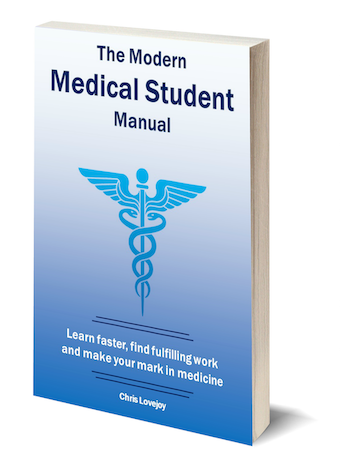The Fundamentals of Fast Learning (Part 1)
Let me tell you about Balraj.
He was a student in my year at university who absolutely loved medicine. He went to all the lectures and spent many late nights in the library studying. In his free time, he’d read research articles, attend conferences and keep up-to-date with the medical world.
The problem was: he was struggling.
Each year, the course would build on content from previous years. He found it increasingly difficult to remember content that had already been covered and so found it harder and harder to keep up with new material. This came to a head in our fourth year, when he failed the exams and had to re-sit them.
Afterwards, we sat down together and tried to understand why. He was a smart student and had aced his exams throughout school. Why was he working harder than everyone else but still failing?
Many medical students will sympathise with this feeling of working endlessly but always feeling behind. Medicine is tough. We’re expected to learn huge amounts of content and are continually tested on it throughout medical school and our career.
Throughout medical school, I saw the different approaches that my friends and colleagues took and the results they achieved. I was given the opportunity to spend over five hundred hours teaching students, including Cambridge medical undergraduates. I saw what worked well and what didn’t.
One thing that I learnt is that it’s not the raw level of intelligence that determines success at medical school. It’s also not just how hard you work. I saw smart people do poorly and less smart people do exceptionally well. Rather, the most important thing is how you work.
At school we’re taught many things but we’re never really taught how to study. Yet there is a lot of research looking at the principles of memory formation and effective learning. Different people learn in different ways but many people go their whole lives without fully understanding how to maximise their personal capabilities.
The benefits of ‘learning how to learn’ can yield rewards for the rest of our medical careers, enabling us to perform better and to have more free time for other things.From my students, friends and personal research, I found that the four most important principles of efficient learning are Spaced Repetition, learning for understanding, creating the conditions for deep work and facilitating continual improvement.
Spaced Repetition
Spaced repetition involves reviewing content at gradually increasing intervals. Research has shown that it dramatically increases the memory retention and thus efficiency of learning. The first scientist to demonstrate this phenomenon was Ebbinghaus.
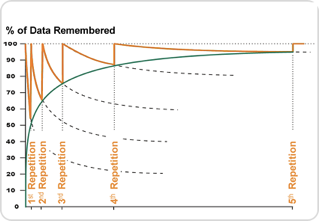
A practical way to use this in medicine is as follows: when you learn some new information, recall it from memory and review your notes after about one hour, then one day, then one week, then one month, then six months and then one year.
The principle is more important than the exact time spacing and can be adjusted around your life and schedule as required. You can organise this in a number of ways, on the micro (facts and concepts) and macro (topics) levels.
Micro (facts) level
One option for the micro level is to use electronic aids, such as Anki (where you can make your own flashcards) and Memrise (where you can use those created by others). These present you with flashcards and will re-present them at increasing intervals, based on your ease of recollection.
I found Anki most useful for fuelling active recall by having a condition name or an important concept on one ‘side’ of the card and lots of reference information copied from my notes on the back.
For example, Anki presents the card like this:
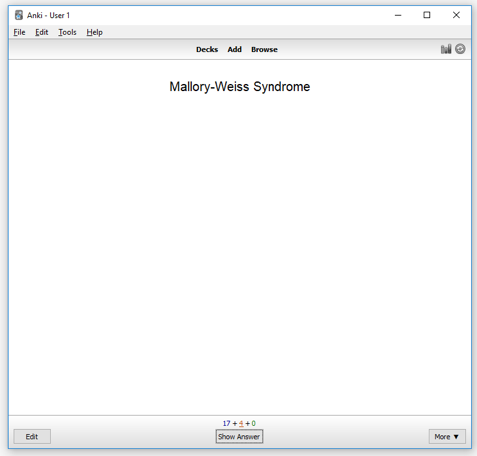
I would then spend about thirty seconds writing out as much as I can about Mallory-Weiss Syndrome (often using the rough format; aetiology, signs and symptoms, pathophysiology, complications, investigations, treatment).
I would then click ‘show answer’ at which point it would show the reference information, as below, for me to see how much I got and what I missed out.
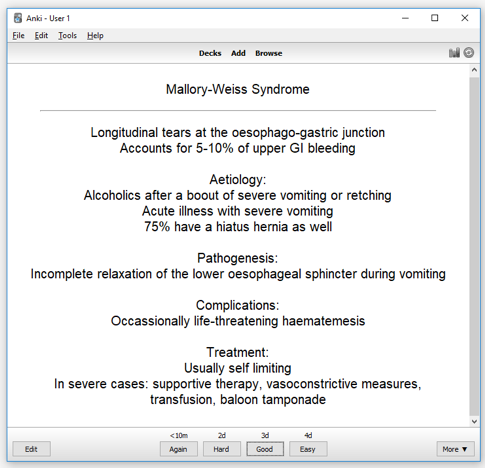
Based on how easy I found it and how much I was able to recall, I would select the appropriate option at the bottom and would then be re-presented with this card after the relevant period of time.
Macro (topics) level
I created a Review System which is easily organised through a central document as shown below. This is only one way to incorporate Spaced Repetition, but I will explain it to demonstrate the principle.
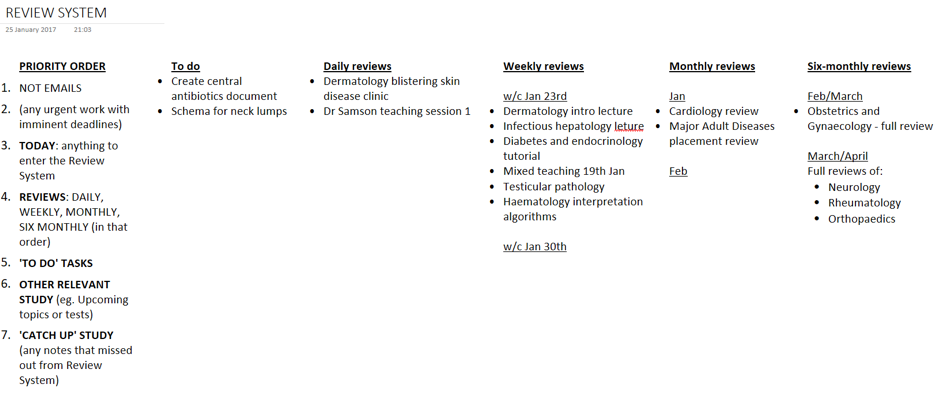
The system works as follows:
At the end of each day, I spend about an hour recapping things that I have seen, learnt and been taught that day. Anything worth reviewing the next day is added to the ‘Daily Reviews’ column.
At some point during the following day, I will review topics in the ‘Daily Reviews’ column (by recalling content from memory and often doing some further study to clarify important concepts). If I feel the topic is worth reviewing again, I will move the topic into the ‘Weekly Reviews’ column. This means that I will review it again in approximately one week’s time and perform the same process (putting some into the ‘Monthly Reviews’ column and so on). Some smaller topics will be grouped into larger topics as they progress right-wards.
Here’s how this works on a daily basis:
Whenever I have a free moment during the day (such as between teaching sessions, before a clinic, between theatre operations or any other time when no learning opportunities are present), I open up the central document and work through the topics for review in the priority order shown above, from left to right. This usually involves grabbing a piece of paper and recalling as much as I can on the topic before later referring to my notes (which I sync to my phone). If necessary, the recall can be purely mental, such as if bored during a long operation.
I have found using this system a very effective way to make the most of gaps during the day. I can recount numerous occasions where I had a gap of 10-30 minutes, during which previously I would have killed time checking my phone or emails, but instead reviewed some content. I would often get home in the evening having covered the majority of my reviews during the day so I had the option of taking the evening off knowing I’d made good progress.
I would estimate that this system alone enabled me to spend 30-40% less time studying with a noticeable improvement in long-term retention. It also meant I was far less stressed during exam period as the majority of the content was in my long-term memory.
Learn for understanding
People fall on a spectrum from those who predominantly learn for memorisation to those who predominantly learn for understanding . Learning for understanding leads to higher percentage retention and for longer periods of time. Abstract facts leak out of your brain, whereas understanding provides the context that will enable longer retention.
Tim Urban explains an analogy that compares knowledge of a topic to a tree :
“If you don’t fully get it, it’s like a tree in your head with no trunk—and without a trunk, when you learn something new about the topic—a new branch or leaf of the tree—there’s nothing for it to hang onto, so it just falls away. By [developing understanding], I build a tree trunk in my head, and from then on, all new information can hold on, which makes that topic forever more interesting and productive to learn about.”
I remember in my first year, I memorised the mechanisms the kidneys use to help maintain homeostasis. While I did well in my physiology exam, I couldn’t even remember the mechanisms by the end of the summer. When I started meeting patients with renal disease on the ward a few years later I realised how this approach missed the point. Learning the content is not just so you can pass the exams. I re-learnt the renal physiology but this time made sure I understood the bigger picture and the clinical relevance. As a result, I can still remember it today and continue to apply the knowledge in clinical situations.
In Medicine, it can feel like we don’t have time to develop a real understanding of a topic because there is so much to learn. We are often assessed in ways that directly test our factual recollection rather than our understanding, such as multiple-choice or true/false questions. As a result, it can be easy to focus on rote learning as many facts as possible. While it requires slightly more initial effort to develop the base understanding, the greater retention makes it much more efficient in the long-run. It also better serves the real aim of medical school which is to become good doctors rather than to pass exams.
It’s not always clear to ourselves where we fall on the spectrum of memorisation vs understanding. It can be easy to assume we understand something well, only for this mirage to fade when something highlights the gaps. However, increasing the amount that we learn by understanding is a habit that can be trained. Again, this can be done on micro (concepts) and macro (topics) levels.
For a more in-depth analysis of the levels of understanding, visit: http://lesswrong.com/lw/1yq/understanding_your_understanding/
Micro (concepts) level
The Feynman method is a useful way to identify any gaps in understanding of a concept and how to solve them:
- Select a concept.
- See if you can explain it in a way that a 5-year-old would understand.
- If you can, rest assured that you understand it.
-
If not, there is one of three areas that you may need to address: understanding, memory and simplicity. Based on the area, consider the following questions:
-
Is there something you don’t understand? -> actively search for the information and understanding to fill this gap.
-
Are you having difficulty remembering certain parts? -> think of an analogy you can use which will make it easier to remember
- Are you confident you understand and remember it but are having difficulty explaining it? -> think of a way to simplify the concept. Is there anything you can remove while still making sense?
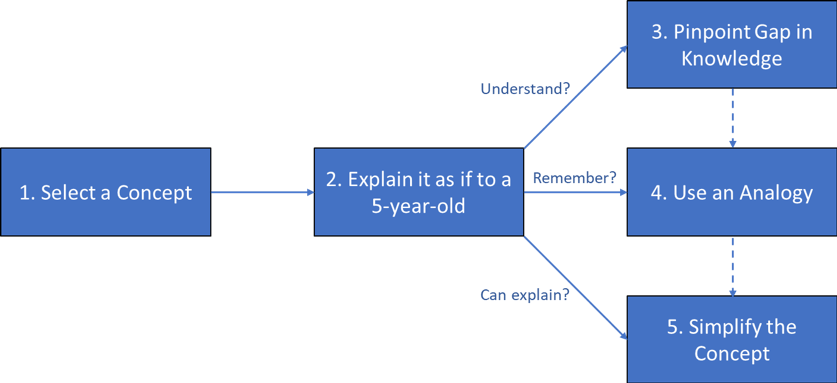
For a detailed example of the Feynman Method in use, click here.
Albert Einstein reportedly once said:
“If you can’t explain it to a six-year-old, you don’t understand it yourself’.
Another technique that facilitates learning for understanding is “Following the Trail of Whys”, as explained in Chapter 1.
Macro (topics) level
Before you learn or review a topic, assess your current state of understanding by asking yourself the following questions:
- What do you already know about the topic? (Write out as much as you can from memory)
- What don’t you know? What don’t you understand?
The purpose of asking these questions is to highlight gaps in your knowledge or memory which you can then fill. Use them to write a set of questions to have in the back of your mind as you study, to act as a mental prompt and keep you on track. When you’re finished, check that you can now answer these questions from memory.
Afterwards, to check whether you do truly understand the content you must actively test yourself. Useful ways to do so include:
- Recall the information from memory. For example, write a three-sentence summary of what you have learnt, write a short essay or make a poster or integrative diagram — you can be creative.
- Practise exam questions (if learning for an exam) — don’t wait until someone else sets them for you or for the exam itself; find your own and see which you can answer and which you can’t!
Continued in Part 2.
This is a chapter from The Modern Medical Student Manual. A full list of chapters are below:
- Introduction: From That Day To This Book
- Chapter 1: Medicine from Fifty Thousand Feet: Perspective, Targets and Limits
- Chapter 2: The Fundamentals of Fast Learning - Part 1 and Part 2
- Chapter 3: Mastering Clinical Medicine - Part 1 and Part 2
- Chapter 4: Increasing our Impact (and the power of Self-Education) - Part 1 and Part 2
- Chapter 5: A Scientific Approach to Research - Part 1 and Part 2
- Chapter 6: Commanding Clearer Communication - Part 1 and Part 2
- Conclusion
Plus Bonus Chapters:
- Bonus Chapter 1: If Medicine Gets You Down
- Bonus Chapter 2: Is Medicine Right For Me?
- Bonus Chapter 3: Memorisation Techniques (by Dr James Hartley)
- Bonus Chapter 4: Learning from Others in Medicine
